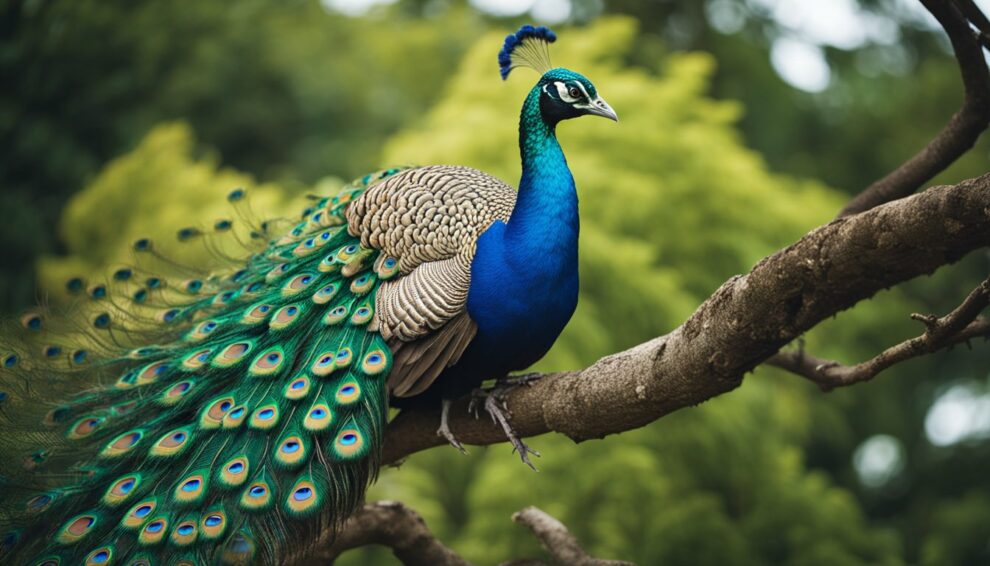Peacocks are known for their stunning and vibrant plumage that never fails to capture attention. But why do these birds have such colorful feathers?
What purpose do they serve? These are some of the questions that have puzzled scientists and bird enthusiasts for decades.

The mysteries of peacock plumage are fascinating, and exploring them can reveal a lot about the natural world.
Peacocks are a type of bird that belong to the pheasant family. They are native to South Asia and are known for their distinctive appearance.
Male peacocks are famous for their iridescent blue and green feathers, while female peacocks have more subdued brown feathers.
Peacocks are not the only birds with colorful feathers, but their plumage is perhaps the most striking.
Understanding why peacocks have such colorful feathers can shed light on the evolution of birds and the role that color plays in the animal kingdom.
So, let’s take a closer look at the mysteries of peacock plumage and uncover the secrets behind these beautiful birds.
The Splendor of Peacock Feathers
Peacock feathers are known for their stunning beauty and vibrant colors.
They are one of the most recognizable features of the peacock, and have been admired and studied for thousands of years.
In this section, we will explore the mysteries of peacock plumage and uncover the secrets behind their splendor.
Colors and Patterns
Peacock feathers come in a variety of colors and patterns.
The most common colors are blue, green, and gold, but they can also be white, brown, and black.
The patterns on the feathers are unique to each bird, and are used to attract mates during mating season.
The male peacock uses its colorful feathers to display its dominance and attract a mate.
Iridescence and Vibrancy
One of the most striking features of peacock feathers is their iridescence.
This is caused by the microscopic structure of the feathers, which reflects light in a way that creates a shimmering effect.
The vibrant colors of the feathers are also due to the presence of pigments, which are produced by specialized cells in the bird’s skin.
Peacock feathers are not only beautiful, but also serve a practical purpose.
The eyespots on the feathers are used to deter predators, by creating the illusion of multiple eyes.
This makes the bird appear larger and more intimidating, and can help to scare off potential threats.
In conclusion, peacock feathers are a marvel of nature, combining beauty and function in a single package.
Their colors, patterns, and iridescence are a testament to the intricate workings of the natural world, and serve as a reminder of the wonders that can be found in even the smallest of things.
Peacocks in the Wild

Peacocks are native to South Asia, where they inhabit forests and open grasslands.
They are best known for their striking plumage, which consists of long, colorful feathers that extend from their backs.
Although peacocks are often kept in captivity for their beauty, they are also fascinating creatures in the wild.
Mating Rituals and Courtship
During mating season, male peacocks display their feathers to attract females.
This is a territorial display, as peacocks are highly competitive and will defend their territories from other males.
The male will fan out his feathers to create a large, colorful display, and then strut around to show off his plumage.
This display is called the “train,” and it can be up to six feet long. If a female is impressed by the display, she will mate with the male.
Predators and Survival Strategies
Peacocks are preyed upon by a variety of predators, including tigers, leopards, and wild dogs.
To avoid being caught, peacocks have developed several survival strategies.
One of these is their ability to fly short distances, which allows them to escape danger quickly.
They are also able to run at high speeds, which helps them outrun predators on the ground.
In addition to their physical abilities, peacocks also have excellent eyesight and hearing, which allows them to detect predators from a distance.
They are also highly territorial and will defend their territories from other males.
This territorial behavior helps to ensure that they have access to food and mates.
Fun fact: Did you know that peacocks are not born with their colorful feathers?
The feathers develop over time, and it can take up to three years for a peacock to reach full maturity.
The Science Behind the Beauty
Peacocks are known for their colorful and striking feathers that are a sight to behold.
But have you ever wondered why these birds have evolved to have such beautiful feathers?
In this section, we’ll explore the science behind the beauty of peacock feathers.

Genetics and Evolution
The colorful feathers of male peacocks are a result of sexual selection, a process in which males display certain traits to attract females.
According to a genetic study of peacocks and closely related pheasants, the magnificent trains on male peacocks, which feature ornamental eyespots called ocelli, evolved because of sexual selection.
The study also revealed that there was a single origin for these feathers, which sexual selection then enhanced.
Physical Structure and Function
The feathers of peacocks are perhaps their most well-known feature. These feathers are not just for show, but also serve a functional purpose.
The feathers have a unique structure that allows them to reflect light in a way that creates the vibrant colors we see.
According to Inside Science, the feathers contain nanometer-scale protein structures that break up incoming light waves, recombine and reflect them as rich, vibrant colors.
This structural coloration is different from pigmentation, which is what gives color to most animals, including humans.
In addition to their colorful feathers, peacocks also have a unique physical structure that allows them to attract females.
Male peacocks have a long, colorful train of feathers that they can fan out to display to females during courtship.
This display is known as a “train-rattling display” and is a key factor in attracting mates.
The train is also thought to be a signal of genetic fitness, as it takes a lot of energy to grow and maintain such a large and ornate structure.
Overall, the science behind the beauty of peacock feathers is a fascinating topic that has captured the attention of scientists for centuries.
By understanding the genetics and evolution behind these feathers, as well as their physical structure and function, we can gain a deeper appreciation for the beauty of nature and the wonders of the natural world.
Peacocks Beyond the Wild

Peacocks are not just found in the wild but are also kept in captivity and domesticated for various reasons.
In this section, we will explore the different ways that peacocks have interacted with humans throughout history.
Domestication and Captivity
Peacocks have been domesticated for centuries for their beauty and ornamental value.
They are often kept in zoos, parks, and private gardens.
The peacock’s colorful plumage makes it a popular attraction for visitors and a favorite subject for photographers.
Their feathers are also used for decoration, fashion, and art.
Peafowl are relatively easy to keep in captivity and require minimal care.
They can adapt to different environments and are not very demanding in terms of food and shelter.
However, they are susceptible to predators and need protection from dogs, cats, and other animals that may harm them.
Cultural and Historical Significance
Peacocks have played an important role in many cultures throughout history.
In India, the peacock is the national bird and is considered a symbol of beauty, grace, and pride.
In Hindu mythology, the peacock is associated with the god Kartikeya and is believed to be his vehicle.
In medieval times, peacocks were a common sight in royal gardens and were often featured in art, literature, and tapestries.
Peacock feathers were also used as a symbol of status and power. In ancient Rome, only the emperor and his family were allowed to wear peacock feathers.
In China, the peacock was associated with royalty and was believed to bring good luck and prosperity.
Conservation
Despite their popularity, peafowl are facing threats in the wild due to habitat loss, poaching, and hunting.
The International Union for Conservation of Nature (IUCN) lists the Indian peafowl as a species of “Least Concern,” but their status may change if conservation efforts are not taken seriously.
Peafowl are also vulnerable to genetic disorders such as leucism, which is a condition that causes white feathers instead of colorful ones.
This can affect their survival in the wild as they may not be able to blend in with their surroundings and avoid predators.
Peacocks are fascinating creatures that have captured the imagination of humans for centuries.
From their colorful plumage to their cultural significance, they have left an indelible mark on our history and culture.
Frequently Asked Questions

How do peacock feathers contribute to their mating rituals?
Peacock feathers play a crucial role in the mating rituals of male peafowl.
During breeding season, male peafowl display their vibrant feathers in a fan-like manner to attract female peafowl.
The display of feathers is accompanied by a series of calls and movements that serve to further impress the female.
The brighter and more colorful the feathers, the more likely the male is to attract a mate.
What are the functions of the ‘eye’ patterns on peacock feathers?
The ‘eye’ patterns on peacock feathers are known as ocelli. These patterns serve multiple functions.
Firstly, they help to create an optical illusion that makes the feathers appear three-dimensional, which is more attractive to females.
Secondly, they help to deflect light and create a shimmering effect that catches the eye of potential mates.
Finally, the ocelli also serve as a way to intimidate predators by making the peacock appear larger and more threatening.
Can the colors of a peacock’s feathers indicate its health or mood?
Yes, the colors of a peacock’s feathers can indicate its health and mood.
Brighter and more vibrant feathers are often a sign of good health and vitality, while dull and faded feathers can indicate poor health.
Additionally, a peacock’s mood can be reflected in the way it displays its feathers.
For example, a peacock that is feeling threatened may puff up its feathers to appear larger and more intimidating.
What role do peacock feathers play in attracting a mate?
Peacock feathers play a crucial role in attracting a mate by signaling to females that the male is healthy, strong, and capable of providing for offspring.
The brighter and more colorful the feathers, the more likely a male is to attract a mate.
Additionally, the way in which a peacock displays its feathers can also be a factor in attracting a mate.
How does the peacock’s feather display relate to natural selection?
The peacock’s feather display is an example of sexual selection, which is a type of natural selection that occurs when certain traits help individuals to attract mates and reproduce.
In the case of peafowl, males with brighter and more colorful feathers are more likely to attract mates and pass on their genes to the next generation.
Over time, this can lead to the evolution of more elaborate and colorful feathers.
What cultural meanings are associated with the vibrant colors of peacock feathers?
Peacock feathers have been used as a symbol of beauty, wealth, and royalty in many cultures throughout history.
In Hinduism, the peacock is associated with the god of thunder and rain, while in ancient Greece, the peacock was associated with the goddess Hera.
In modern times, peacock feathers are often used in fashion and home decor to add a touch of color and elegance.









